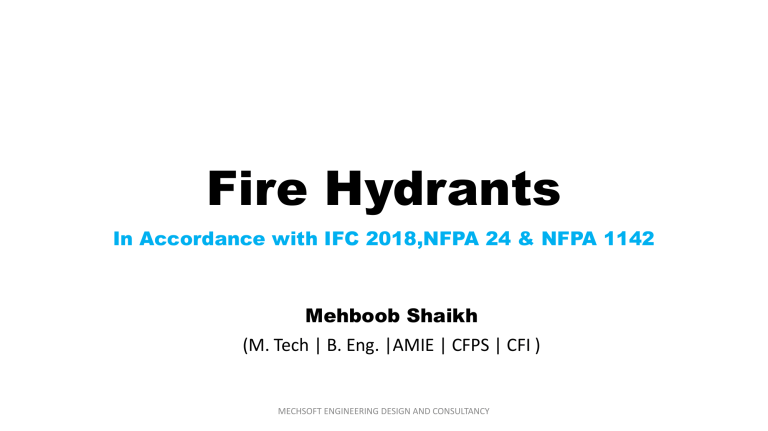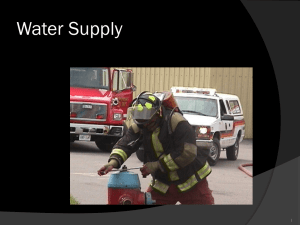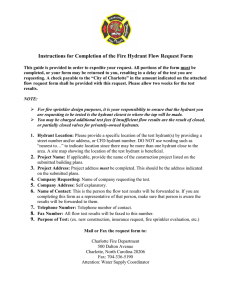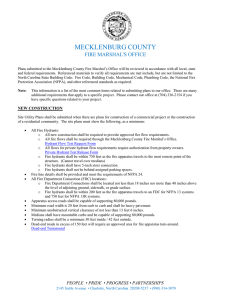
Fire Hydrants In Accordance with IFC 2018,NFPA 24 & NFPA 1142 Mehboob Shaikh (M. Tech | B. Eng. |AMIE | CFPS | CFI ) MECHSOFT ENGINEERING DESIGN AND CONSULTANCY Contents ❑Types of Hydrants ❑Location of Fire Hydrants ❑Clear Space around the Hydrants ❑Distance Between the Fire Hydrants ❑Fire Hydrant Accessibility and Access ❑Fire Hydrant Flow Testing ❑Hydrant Loop Testing MECHSOFT ENGINEERING DESIGN AND CONSULTANCY Types of Fire Hydrants Dry Hydrants People Generally get confused between this Two Wet hydrants Wet Barrel According to NFPA 1142 Standard on Water Supplies for Suburban and Rural Fire Fighting: Key Sentence “Dry hydrant is an arrangement of pipe permanently connected to a water source other than a piped, pressurized water supply system that provides a ready means of water supply for fire-fighting purposes and that utilizes the drafting (suction) capability of a fire department pump” MECHSOFT ENGINEERING DESIGN AND CONSULTANCY Dry Barrel DRY FIRE HYDRANTS In dry hydrant water has to be drawn from the supply (lake, pond, reservoir, tank) by a fire pumper through a pipe that is typically located underground MECHSOFT ENGINEERING DESIGN AND CONSULTANCY WET FIRE HYDRANTS MECHSOFT ENGINEERING DESIGN AND CONSULTANCY Private vs Public Fire Hydrants Everything after street valve will be maintained by Property owner Fire Hydrant Public Fire Line private to building Street Valve 8” Water mains MECHSOFT ENGINEERING DESIGN AND CONSULTANCY LOCATION 4.5 inch should face the street 36” of clear space must be maintained around the hydrant Min. 457 mm Max. 914 mm Bottom of the safety flange should be at least 2.5 inches above the grade where it is set Approximately 6 feet from traffic lanes when no curb is present MECHSOFT ENGINEERING DESIGN AND CONSULTANCY LOCATION No parking within 15 feet of a fire hydrant, which is marked by signage and painting!!! MECHSOFT ENGINEERING DESIGN AND CONSULTANCY DISTANCE FROM THE BUILDING Proposed Building Avoid placing it in Collapse Zone i.e. perpendicular to the walls Wall Collapse Fire hydrants must be placed Zone (Collapse zone = 1.5 X height of building) at least 40 feet from the building they serve. Wall Collapse Zone At least 40 feet from the building they serve. MECHSOFT ENGINEERING DESIGN AND CONSULTANCY Public Street DISTANCE FROM THE BUILDING Proposed Building Proposed walkway 25 feet 60 feet Proposed walkway Criss-cross fire hydrant Proposed Building 90 feet 30 feet Proposed Building Too close to building MECHSOFT ENGINEERING DESIGN AND CONSULTANCY DISTANCE BETWEEN THE HYDRANTS Building Type Maximum Distance between Hydrants(feet) Industrial buildings and warehouses Schools, day care centers 250 What Exactly these distances means ..? 300 Offices, commercial establishments, church, hospitals, nursing homes 350 Apartments, multifamily dwellings, town houses 350 Single-family dwellings 500 These measurements indicate what one fire hydrant can cover along the fire access roadMECHSOFT depending on building fire load and no. of fire ENGINEERING DESIGN type, AND CONSULTANCY streams required FIRE HYDRANT COVERAGE Within 150’ Proposed Building Path 2: 350 feet max coverage along required vehicle path IIB, B, 2-story, 40 height, not sprinklered Fire trucks connect supply hoses to fire hydrants; so the distance is based on how far the truck can travel from a fire hydrant MECHSOFT ENGINEERING DESIGN AND CONSULTANCY Within 150’ Path 1: 350 feet max coverage along required vehicle path FIRE HYDRANT COVERAGE Plot Fire Truck Access way Fire Truck Access way Is it a right way to show hydrant coverage ..? i.e. by drawing a circle around the hydrant. MECHSOFT ENGINEERING DESIGN AND CONSULTANCY FIRE HYDRANT COVERAGE 143’-9” 106’-3” ❑ 143’–9”+ 106’–3” = 250’ Path of truck travel with hose lay We need to check coverage by laying hose along the truck access path considering all possible obstructions!!! Plot Coverage is not met if we consider a circular coverage around hydrant MECHSOFT ENGINEERING DESIGN AND CONSULTANCY Why Flow rate tests ❑Firefighters need to know how much water a hydrant will deliver. This tells them how much fire can be extinguished using that particular hydrant. ❑Knowing the capacity of a hydrant is just as important as knowing the capacity of a pumper. ❑If the hydrant cannot supply enough water, the pump capacity does not mean as much. MECHSOFT ENGINEERING DESIGN AND CONSULTANCY PERSONNEL AND EQUIPMENT FOR FLOW TESTS EQUIPMENT NAME DESCRIPTION QTY Pitot Tube For each flow hydrant, one Pitot tube with a pressure gauge capable of reading from 0 to 60 psi (420 kPa). 1 One outletnozzle cap One outlet-nozzle cap that will fit the outlet nozzle of the residual hydrant. The outlet-nozzle cap is equipped with a pressure gauge capable of reading from 0 up to 25 psi (175 kPa) greater than the pressure expected in the residual hydrant. 2 A Ruler A ruler to measure the inside diameter of the outlet nozzle of each flow hydrant. 1 MECHSOFT ENGINEERING DESIGN AND CONSULTANCY REPRESENTATION PERSONNEL AND EQUIPMENT FOR FLOW TESTS EQUIPMENT NAME DESCRIPTION QTY Hydrant Wrench One hydrant wrench to operate the residual hydrant and one to operate each of the hydrants at which the flow will be measured. 2 Discharge diffuser (Optional) One discharge diffuser to absorb the energy from the hydrant flow so that it is contained, where necessary, to avoid property damage or to minimize the effect on traffic. 1 One Person One person to read the gauge on the residual hydrant and one person to read the gauge on the Pitot tube for each of the flow hydrants. 1 MECHSOFT ENGINEERING DESIGN AND CONSULTANCY REPRESENTATION PERSONNEL AND EQUIPMENT FOR FLOW TESTS EQUIPMENT NAME Hose DESCRIPTION QTY 50 ft section of 3” and/or 5” hose 2-4 Allen wrench 1 Clipboard 1 Paint supplies Paint supplies (spray paint & masking tape) - Record keeping material Record keeping material - MECHSOFT ENGINEERING DESIGN AND CONSULTANCY REPRESENTATION Office Planning Prior to Field Testing MECHSOFT ENGINEERING DESIGN AND CONSULTANCY Set up ▪ Decide which hydrant will be your pressure hydrant and which will be your flow hydrant(s). The pressure hydrant will be used to measure static pressure and residual pressure. ▪ Decide how many flow hydrants to use. As a rule of thumb, you should flow enough hydrants at the same time such that the residual pressure drops at least 25% from the static pressure. @ Test Hydrant(Static/Pressure/Residual Hydrant) : ▪ Attach gauge cap to test hydrant tighten all other caps ▪ Open test Hydrant, Vent Air from hydrant body through valve on the gauge assembly. Close it when air is vented. ▪ Open the hydrant slowly and fully; ▪ Read and record the pressure. This is the Static Pressure. MECHSOFT ENGINEERING DESIGN AND CONSULTANCY Set up ▪ @ Flow Hydrant: • Measure and record the inside diameter (ID) of the outlet nozzle from which the flow is measured. The inside diameter (ID) measurement is taken to the nearest 1/16 in. (0.159 cm). • Insert a hand into the nozzle opening and feel the entrance shoulder to determine the nozzle coefficient (0.9 for a smooth rounded shoulder, 0.8 for a square shoulder, and 0.7 for a nozzle that protrudes into the barrel). • Install and arrange any hoses or diffusers necessary to minimize effect on traffic or landscaping. MECHSOFT ENGINEERING DESIGN AND CONSULTANCY FIELD PROCEDURE FOR FLOW TESTS 1. Make provisions for minimizing interruptions to traffic and for adequate drainage of water. 2. At this point it would be helpful to have one or more assistants and a reliable method of communication such as two-way radios to perform an efficient test. 3. Open each flow hydrant slowly and fully. Open one hydrant at a time to avoid a pressure surge 4. Wait for the pressure at the pressure hydrant to stabilize, read and record this pressure. This is the Residual Pressure. Then signal the persons stationed at the flow hydrants to take Pitot readings. The readings for residual pressure and the Pitot readings should be taken at the same time for an accurate flow. MECHSOFT ENGINEERING DESIGN AND CONSULTANCY FIELD PROCEDURE FOR FLOW TESTS 5. To take a Pitot reading, hold the Pitot gauge approximately ½ of the diameter away from the nozzle in the center line of the nozzle. Read and record this pressure. This is your Pitot or velocity pressure. 6. For an accurate reading, hold the Pitot tube in the center of the nozzle, with the axis of the Pitot tube opening parallel to the direction of flow. The Pitot tube should be held away from the end of the nozzle at a distance of about half the nozzle diameter. 7. If sediment appears, continue to flow water until the main has been flushed 8. Close each flow hydrant, one at a time, very slowly. Closing a hydrant too fast will cause damage to the hydrant or to water mains. MECHSOFT ENGINEERING DESIGN AND CONSULTANCY FIELD PROCEDURE FOR FLOW TESTS 9. For reasonably accurate test results, the pressure drop between the static and the residual pressures should be at least 10 psi (70 kPa). 10. If the distribution system is strong (as it should be near a supply main) and the pressure drop is less than 10 psi (70 kPa), an additional flow hydrant should be added to the test. 11. Enough hydrants should be opened to drop the Static pressure by at least 10 psi (70 kPa); however, if more accurate results are required, the pressure drop should being the Residual pressure as close as possible to 20 psi (138 kPa). The flow available at 20 psi (138 kPa) can be determined by dropping the Residual pressure to exactly 20 psi (138 kPa) or can be determined at any Residual pressure by graphical analysis, or by formula calculations. MECHSOFT ENGINEERING DESIGN AND CONSULTANCY Equations Qr=29.83 X CdX D^2 X Sqrt(Pp) ----------------(Eqn.1) Qf=Qr X ((Ps-20)/(Ps-Pr))^0.54 ----------------(Eqn.2) where: ▪ Qr is the residual flow at the Pitot pressure measured in gpm ▪ cd is the friction loss coefficient (usually 0.9 for a smooth 2½” opening) ▪ D is the diameter of the opening in inches ▪ Pp is the Pitot pressure in psi ▪ Qf is the FIRE FLOW in gpm at 20 psi ▪ Ps is the static pressure in psi ▪ Pr is the residual pressure in psi MECHSOFT ENGINEERING DESIGN AND CONSULTANCY Example You Perform a Hydrant Test and gain the following results: 1. 2. 3. 4. 5. Ps (Static pressure) = 140 psi Pr (Residual pressure) = 125 psi Pp (Pitot pressure) = 120 psi cd = 0.9 because the inside of the nozzle was smooth. D = 2.5 inches MECHSOFT ENGINEERING DESIGN AND CONSULTANCY Example ❑Calculate Qr (residual flow): = 29.83 × 0.9 × (2.5)2 × square root of 125 = 29.83 × 0.9 × 6.25 × 11.18 = 1,876 gpm ❑Calculate Qf (fire flow): = 1876 x ((140- 20)/(140- 125))^0.54 = 1876 x (8)^0.54 (raise 8 to the 0.54 power) = 1,876 × 3.07375 = 5,766 gpm MECHSOFT ENGINEERING DESIGN AND CONSULTANCY Result ❑ That system has the capacity to flow 5,766 gallons per minute at 20 psi residual pressure. MECHSOFT ENGINEERING DESIGN AND CONSULTANCY Why…? Marking of Hydrants The marking of hydrants is important for two reasons. 1. It immediately tells fire crews the number and capacity of the fire main system they are hooking into. 2. It shows that the owner is complying with this program. Historically, fire crews have trusted public hydrants above private ones, because the City hydrants are on a routine maintenance schedule, and, generally, the likelihood of running into problems is lessened. MECHSOFT ENGINEERING DESIGN AND CONSULTANCY Marking of Hydrants Classification of Hydrants. Hydrants should be classified in accordance with their rated capacities [at 20 psi (1.4 bar)residual pressure or other designated value] as follows: 1. Class AA — Rated capacity of 1500 gpm (5700L/min) or greater 2. Class A — Rated capacity of 1000–1499 gpm (3800– 5699L/min) 3. Class B — Rated capacity of 500–999 gpm (1900–3799L/min) 4. Class C — Rated capacity of less than 500 gpm (1900 L/min) MECHSOFT ENGINEERING DESIGN AND CONSULTANCY Marking of Hydrants The tops and nozzle caps should be painted with the following capacity-indicating color scheme to provide simplicity and consistency with colors used in signal work for safety, danger, and intermediate condition: 1. Class AA — Light blue 2. Class A — Green 3. Class B — Orange 4. Class C — Red ❑NFPA 291 recommends that only the bonnet and caps be color coded. The rest of the barrel should be a different color ❑For rapid identification at night, it is recommended that the capacity colors be of a reflective-type paint. MECHSOFT ENGINEERING DESIGN AND CONSULTANCY Marking of Hydrants MECHSOFT ENGINEERING DESIGN AND CONSULTANCY Fire Main Loop Test with Fire Hydrant Why..? ❑To determine if the condition of the system is adequate to support a Worst Case Credible Event(WCCE) need for firewater. ❑The condition of the piping, leaks, existence of closed valves or sediment, operability of valves for firewater delivery systems MECHSOFT ENGINEERING DESIGN AND CONSULTANCY Fire Main Loop Test with Fire Hydrant When water flow encounters a loop or grid, two things occur ❑The flow splits into a determinable ratio ❑The pressure drop across each of the two legs will be the same There are four methods to test a loop or grid system: (1) Isolate the Legs (2) Choose Two Hydrants on a Large Main (3) Simultaneous Flow (4) Single Hydrant Flow Test MECHSOFT ENGINEERING DESIGN AND CONSULTANCY Isolate the Legs : Test -1 Measure static pressure, flow and residual pressure SP1 RP1 Q1 Shut Valve -1 1 2 Source MECHSOFT ENGINEERING DESIGN AND CONSULTANCY Isolate the Legs : Test -2 Measure static pressure, flow and residual pressure 1 Shut Valve -2 2 Source MECHSOFT ENGINEERING DESIGN AND CONSULTANCY SP2 RP2 Q2 Isolate the Legs : Test -3 Measure static pressure, flow and residual pressure Both valve opened 1 2 Source MECHSOFT ENGINEERING DESIGN AND CONSULTANCY SP3 RP3 Q3 Result ❑The static pressure should be identical in each of the three tests. A drop in static pressure in test 1 or 2 is indicative of a restriction and a leak. ❑In the event of a 100% restriction, no water will come out of the hydrant ❑ In the event of a partial restriction, the residual pressure and/or the flow is significantly diminished. ❑Further flow testing on different hydrants can usually narrow down the location of the restriction MECHSOFT ENGINEERING DESIGN AND CONSULTANCY Choose Two Hydrants on a Large Main Dia. 4” Dia. 4” Dia. 6” Dia. 6” Both valve opened 1 2 Source MECHSOFT ENGINEERING DESIGN AND CONSULTANCY Thank You MECHSOFT ENGINEERING DESIGN AND CONSULTANCY




